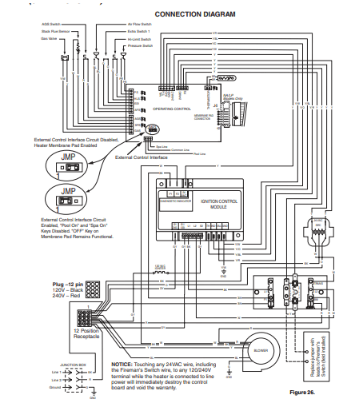Sta Rite pool heater ignition lockout happens when your heater has tried to fire up 3 times and consecutively failed.
When your heater is in a lockout, you can’t operate it without fixing the problem and resetting it. So, you have to identify the cause of ignition failure and fix it before resetting the system.
The possible causes of ignition failure are- failed ignitor, bad ignition control module, defective flame sensor, blower not working, blocked pool filter, low pump pressure, damaged gas valve, clogged burner orifice, and tripped safety switches.
Keep reading our Sta-Rite pool heater troubleshooting guide to get your heater out of the ignition lockout ASAP.
Table Of Contents
- Sta Rite Pool Heater Ignition Lockout [9 Easy Fixes]
- 1. Failed Ignitor
- 2. Bad Ignition Control Module
- 3. Defective Flame Sensor
- 4. Blower Not Working
- 5. Blocked Pool Filter
- 6. Low Pump Pressure
- 7. Damaged Gas Valve
- 8. Clogged Burner Orifice
- 9. Tripped Safety Switches
- FAQs:
- Why is my heat pump fan not turning?
- Does a pool heater have a pilot light?
- What does a thermistor do in a pool heater?
- How much does it cost to install a solar pool heater?
- Why is my pool heater not heating?
- Conclusion
Sta Rite Pool Heater Ignition Lockout [9 Easy Fixes]
When your heater is in ignition lockout, the diagnostic LED flashes 3 times to indicate that the system is in ignition lockout.
So, if that is happening, you can be sure your heater has one of the following issues that we will take a look at in detail. We will also share the simplest solution with you.
1. Failed Ignitor
The ignitor creates a spark to directly light up the burner. Therefore, with a failed ignitor, your heater’s burner won’t light. Your heater LED indicating 3 flashes ignition lockout can be happening because of a failed igniter.
Solution:
You need to access your heater ignitor and look for any signs of physical damage. If the ignitor is twisted, chipped, cracked, or damaged, it should be replaced.
Use pliers to remove the plug on the wires to detach them from their sockets within the pool heater if there was no evident damage to the ignitor. You need a multimeter to test the ignitor for continuity.
First, make sure the multimeter is tuned to the lowest resistance test. The probes should then be connected to the igniter plug’s tips.
The ignitor is faulty and has to be changed if the multimeter shows a reading of infinity or zero.
2. Bad Ignition Control Module
The Ignition Module employs a microprocessor to continuously and safely monitor, evaluate, and control the gas flame holder’s appropriate performance.
The heater can run only after the ignition control module allows it to. So, a malfunctioning ignition control module can be why your Sta Rite pool heater won’t ignite.
Solution:
You need to replace the ignition control module, ICM, to solve this issue. The Sta-Rite ignition control module replacement process is given below.
- To access the ICM, your heater’s left side panel needs to be removed. Take a picture of the wire connections to the ICM to remember where each wire goes. Disconnect the wires connecting the ICM to the Max-E-Therm heater.
- Detach the old ICM and take the new one and insert it in the heater’s junction box chamber. Connect the wires to the new ICM referencing the picture you took. Put everything back together when done.
3. Defective Flame Sensor
The flame sensor is utilized as a gas leak detector. The ignition control uses the flame sensor, which is an electrode, to identify the “rectification” of current passing through the flame.
The gas valve opens to light the burners only after detection. The Sta-Rite pool heater will not ignite if the flame sensor begins to malfunction.
Solution:
To see if the flame sensor is sending a signal to the gas valve, connect a multimeter capable of measuring microamps (A) in series between the wires feeding into the gas valve and sensor terminal. The electric supply must be switched on while doing this test.
Connect the lead from the flame sensor to any one of the meter’s probes. Attach the sensor terminal to the meter probe on the other side.
Adjust the thermostat higher and check the reading once the burners have ignited. The reading should be in the range of 5 to 10 A. If it reads less than that, the sensor is bad and needs to be replaced.
4. Blower Not Working
A malfunctioning blower can be why your heater is failing to ignite. Without the blower operating, the heater won’t get enough airflow.
This increases the chances of the pool heater overheating. That’s why the heater won’t ignite.
Solution:
Verify that the fan is running. If not, the blower motor could be broken. The issue could possibly be with the wiring, or the blower could be receiving insufficient voltage.
You must determine which of these issues is causing the blower to malfunction. Look at the Sta-Rite pool heater wiring diagram below to verify the connections.

5. Blocked Pool Filter
A pool filter can easily get clogged with debris and dirt which limits the water flow of the pool heater. Your heater needs a minimum water flow rate to operate. So, this can be why it won’t ignite.
Solution:
You need to check your pool filter to see if the elements are dirty. Backwash the pool filter if they appear dirty. Clean out the pool skimmer basket.
It is very important that you clean the pool filter every 2-3 months. Most pool heater issues are caused by a clogged pool heater.
6. Low Pump Pressure
Low pump pressure can cause ignition failure. If your pump pressure reading is lower than required, the following things may be wrong.
- Pump and Skimmer Baskets are Clogged up
- Reduced water level
- Skimmer lines clogged
- Pool Pump Impeller Clogged or Damaged
- there is a leak in the water pump inlet lines
- The pressure gauge is broken.
- Multiports or 3-way valves are leaky
Solution:
Make sure that the skimmer basket is empty and the lines aren’t clogged. Check the pool pump impeller for damage and replace it if necessary. Clean the impeller up if dirty.
Verify that the water level is appropriate and the lines going into the pump are not cracked or damaged in any way.
Bleed out the pump in case there are air leaks. Replace the pressure gauge that is broken. Replace the multiports or 3-way valves if the issue is still not fixed.
7. Damaged Gas Valve
The gas valve controls the amount of gas that enters the manifold. It only permits flow when the temperature control system demands heat and all safety precautions have been taken. As a result, if your gas valve fails, your heater will not turn on.
Solution:
Look for the two wires connected to the solenoid terminals on the top or side of the gas valve. Disconnect the connections from the gas valve’s terminals.
Each wire is connected to a terminal via a push-on clip that can be withdrawn. Note where the wires link to the valve so you may rejoin them later.
Set the test control on the multimeter to “mV.” Connect the multimeter’s tester probes to every one of the gas valve’s terminals.
From 145 to195 millivolts is a common reading. The gas valve is defective if the reported reading is not within this range. It will have to be replaced.
8. Clogged Burner Orifice
The burner opening could be obstructed by dust or calcium deposits. It may make it difficult for the burners to light correctly and cause pool heater ignition failure.
Solution:
You’ll need to repair the burner tube to get the pool heater working properly again. To replace the tube on your own, follow these steps:
- Shut down your pool heater and switch on a nearby tap for around five minutes. Remove the lowest access panel from the water heater.
- By unscrewing and removing the old tube’s base from the gas valve. The burner tube should be replaced.
- Reconnect the base of the replacement burner tube to the gas valve with an adjustable wrench for a snug fit.
- By turning on the water heater, you can see if it’s working properly. If the problem persists, hire a mechanic to examine it thoroughly.
9. Tripped Safety Switches
The safety switches keep your unit safe from harm. When these switches identify a fault with the pool heater, they trip and shut off the power.
Pressure switches, high-limit switches, automated gas shutoffs, and airflow switches all have the potential to trigger for a number of reasons.
The air pressure switch and other safety switches must be closed for the ignition module to work.
Solution:
You’ll almost likely get an error code if either of these safety switches trips. It’s likely that the service heater light on the Sta-Rite will turn on.
The error codes indicate which safety switches are active. To reset the switch, you must first figure out why it tripped. Your heater should be able to turn on after you’ve reset the safety switch.
FAQs:
Why is my heat pump fan not turning?
If the compressor is operating but the fan is not, either the fan motor or the capacitor has burned out. But first, make sure there’s no debris! If your blower is too dirty it can affect its operation.
Does a pool heater have a pilot light?
A modern pool heater is likely not to have a pilot light. Instead, they have electrical igniters that produce sparks to light up the burner.
What does a thermistor do in a pool heater?
The thermistor reads the temperature and determines whether the pool water needs more heating or not to reach the set temperature. The thermistor determines whether the thermostat will call for heat or not.
How much does it cost to install a solar pool heater?
The cost of purchasing and installing a solar pool heating system is typically between $2,500 and $4,000. Depending on local fuel costs and solar resource availability, this can pay for itself in 1 to 7 years.
Why is my pool heater not heating?
Insufficient gas pressure, low airflow, or a malfunctioning blower can contribute to your heater not heating. Check that the gas is switched on and that the propane tank is filled. Read our article on pool heaters not heating for more details.
Conclusion
Now that you know what causes Sta-Rite Pool Heater Ignition Lockout, hopefully, you will get your heater running in no time. In case you are having any additional issues with your Sta-Rite pool heater, leave us a comment.

